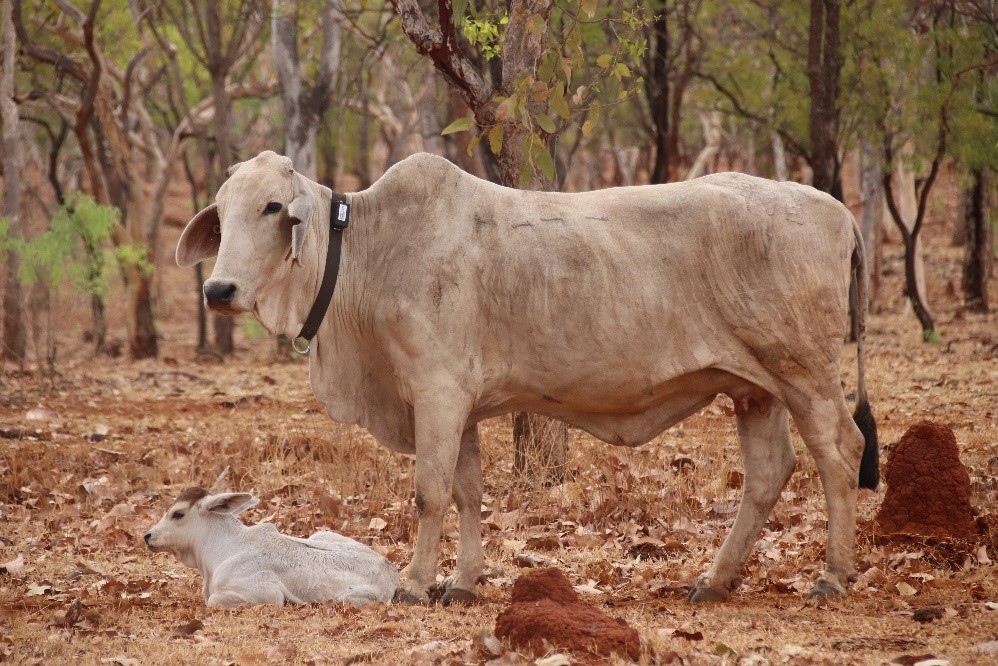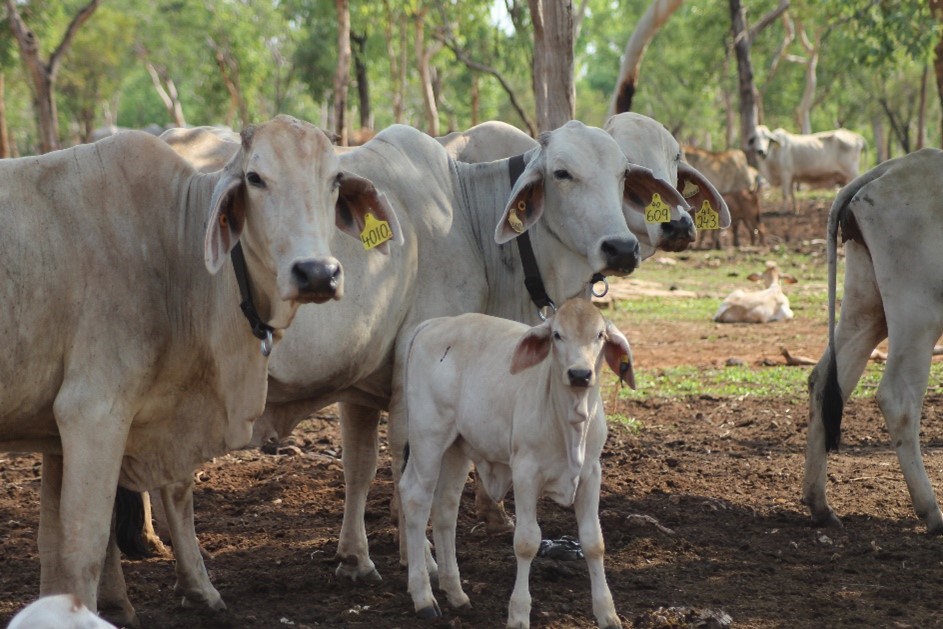CalfWatch – Developing a system to remotely monitor calving and study calf loss in extensive situations in Northern Australia
Key findings
- Cows with bottle teats immediately after calving are a major cause of calf loss in an extensively managed Northern Territory beef herd.
- Udders of the cows with bottle teats had returned to normal appearance several weeks after calving. If this is representative of other herds in northern Australia it is likely these cows are not being culled from the breeder herd at muster.
- A system for remotely monitoring calving using birth sensors and GPS collars was successfully developed, allowing for research into causes of calf loss soon after birth to be conducted.
Calf loss is a major source of lost income for northern beef producers. It has been estimated that neonatal calf loss costs north Australian cattle producers in excess of $53 million annually. Reducing calf loss will improve weaning rates (a major profit driver), and also the profitability of northern beef operations.

In northern Australia it is not uncommon for calf loss to exceed 30% in first calf heifers and 15% in cows; halving these losses would provide significant benefits. However, to date it has been difficult to investigate the causes, as calving females are difficult to find in large paddocks. Additionally, calf carcasses are even more difficult to find under extensive conditions, preventing autopsies from being carried out.
The CalfWatch project aimed to develop a system to remotely monitor calving under extensive conditions in northern Australia and use it to investigate calf loss over two calving seasons at Manbulloo station near Katherine, Northern Territory (NT).
Ultimately this research has the potential to reduce calf loss and improve the profitability of northern beef businesses.
Materials and methods

Birth sensors and alert system
DITT staff worked with University of Florida researchers to modify existing birth sensors to increase their range and enable use in locations where mobile phone coverage was limited. The system used intra-vaginal birthing sensors that emitted a UHF signal when a rapid temperature change was detected (when expelled during calving). The signals were received by antennas in a low-power wide-area network (LPWAN) and transferred by a gateway, via the internet to servers owned by the sensor manufacturer. Four gateways with external antennas were mounted on 12 m high towers to give adequate coverage of the 2,215 ha uncleared paddock of native pasture (which was approximately 7.7 km long and 6 km wide at the widest point). Each tower had a read range of about 1.8-2 km in 360 degrees from the tower.
Calving alerts were transmitted in real time to a supporting website and the people monitoring calving received an email notification.
GPS tracking
A pilot phase demonstrated that GPS tracking was required to locate cows when a calving alert was received. As a result, suitable GPS tracking collars were sourced that recorded location every 15 min. This enabled calving sites and cows to be located for observation around the time of birth and later.
Cattle
The CalfWatch system (birth sensors and GPS tracking collars) was subsequently used to investigate the causes of calf loss over two calving seasons at Manbulloo station Around 200 cows per year were fitted with birthing sensors and GPS tracking collars in August of 2019 and 2020. Observations were recorded during calving from October to early January. Post-mortems were conducted on any calf carcases that were found in time for this to be done (within 12 hours).
Results
Performance of the birth sensors was quite good in the first calving season (2019) when 85% worked correctly, but disappointing in the second calving season (2020) when only 51% worked correctly. In theory, birth sensors can be re-used several times, but the disappointing performance in the second calving season suggests this may not be a good strategy.
When a calving alert was received and the cow had a working GPS collar, the remote calving monitoring system worked well and enabled the cows to be found and calving observations to be recorded. However, if a cow did not have a working GPS collar then in most cases it was not possible to locate them at calving in the large paddock. In 2019, the GPS collars were working on 51% of cows when an alert was received, and following improvements to the collar design this figure improved to 82% in 2020. Overall, the percentage of cows that had correctly functioning birth sensors and GPS tracking systems when they calved was about 43% in both years.
Despite the shortcomings with the technology, it was possible to record calving outcomes for most cows using a combination of the technology and visual observation. This was because the dry conditions experienced during calving in these years meant that most cows congregated around the only water point in the paddock during the day. This enabled most cows to be observed near the water trough in the days after calving. As a result, calving outcomes were able to be determined for 208 pregnancies in 2019 and 192 pregnancies in 2020.
Calf loss rates were 17% in both 2019 and 2020. While the major causes of loss were bottle teats (6% in 2019 and 5% in 2020), and “unknown causes” (8% in 2019 and 10% in 2020).
There were numerous minor (1% or less) causes of calf loss during both calving seasons including:
- early abortion
- dystocia
- infection and septicaemia via the umbilical cord
- pneumonia
- deformity
- wild dog attack.
Where calf losses were classified as being from unknown causes it was because a calf carcase was not found to investigate the cause and no observations were recorded that gave clues as to the cause of death (for example, bottle teats noted). The majority of the cases of calf loss due to unknown causes were in cows whose GPS tracking collars were not working at the time of calving and so they were not able to be observed. However, if a cow was able to be located but appeared to be agitated by observers approaching, she was left alone for a few days so as not to contribute to stress and possibly mismothering. In both of these situations it is possible that a proportion of the calf losses due to unknown causes may have been due to poor mothering (cows abandoning calves).
Discussion and conclusion
Bottle teats post calving
One of the major findings of the project was that bottle teats are likely to be a bigger problem in extensive northern herds than previously thought and it is likely that cows with bottle teats are remaining undetected in herds and losing multiple calves.
The CalfWatch system allowed a greater number of cows to be observed shortly after birth than normally happens in extensive situations, and from these early observations, a number of cows that lost their calves were observed to have bottle teats shortly after calving. However, several weeks later (after losing their calves) their udders appeared normal and so they would not be identified as having bottle teats at a muster several months later.
If this is typical of northern herds then it is likely that bottle teats are a bigger problem than previously thought, and culling of all cows that don’t raise a calf to weaning might be a worthwhile strategy to remove these cows from the herd.

Behavioural observations
The birth sensor expulsion times recorded during this study showed that most cows calved during daylight hours. Studies in the USA have shown night feeding results in a high proportion of cows calving during the day and this may explain the observation in this study, since the cows mostly grazed at night (due to no pasture being available near the water trough where they congregated during the day).
It is common in northern Australia for cattle to be managed in large mobs and to congregate around water points during the day, resulting in the area around water points becoming over grazed. Therefore, there is no grass to eat during the day near the water point and cattle walk away from the water in the late afternoon to graze during the night (resulting in night feeding and daytime calving).
It seems logical that if most calves are born during the day during the hottest time of the year, that providing shade in areas where there is none may reduce calf loss. There is another research project currently underway investigating this.
CalfWatch system performance
The CalfWatch project increased the understanding of calf loss in extensive northern herds and successfully developed a system to remotely monitor calving and assist with studying calf loss. While the poor performance of the GPS tracking collars in the first year and the birth sensors in the second year resulted in the system only working properly in <50% of cases in 2019 and 2020, the improvements in GPS collar design and only using birth sensors once should allow around 80% of calving cows to be found using the system in future.
Future applications
However, efforts are underway to develop collars that can identify calving from accelerometer data and send calving alerts and GPS data in real time. This would enable birth date and location to be identified remotely in extensive areas without the need for birth sensors. This would be advantageous as birth sensors are invasive, expensive (especially if they can only be used reliably once) and their use is quite complicated. Therefore, they are only likely to be used for research purposes. However, if collars that give calving time and location in real time can be developed, then in addition to being a tool for research, they may be useful in monitoring high value animals during calving and enabling more animals to be involved in Breedplan recording where knowing birth date is necessary.
Publications
- CalfWatch final report (PDF, 2.9 MB)
- Webinar recording: CalfWatch – Developing a system to remotely monitor calving in northern Australia (35 minutes)
- CalfWatch presentation, NBRUC 2019 (PowerPoint, 6 MB)
- Katherine Research Station Field Day presentation notes (Word, 50 KB)
Project details
CalfWatch is co-funded by Meat & Livestock Australia and the Northern Territory Government and is due to conclude in October 2020.
For further information about CalfWatch, contact Tim Schatz, Principal Beef Research Scientist, Northern Territory Department of Industry, Tourism and Trade on 08 8999 2332.